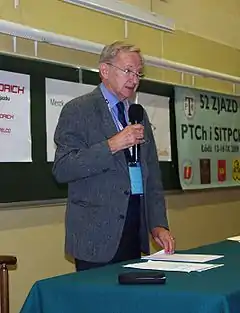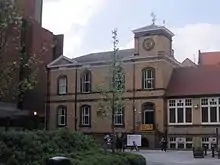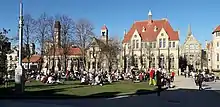Department of Chemistry, University of Manchester
The Department of Chemistry at the University of Manchester is one of the largest Departments of Chemistry in the United Kingdom, with over 600 undergraduate and more than 200 postgraduate research students.
 The School of Chemistry from Brunswick Park | |
| Director | Nik Kaltsoyannis |
|---|---|
| Location | , |
| Affiliations | |
| Website | www |
The department has comprehensive academic coverage across the chemical sciences and in all the core sub-disciplines of chemistry, with over 120 postdoctoral researchers.
Current Management Board
- Head of School: Prof. David Procter
- Head of Education: Dr. Alan Brisdon
- Undergraduate Program Director: Dr. Andrew Regan
- Subject Lead (Inorganic): Prof. David Collison
- Subject Lead (Organic): Dr. Andrew Regan
- Subject Lead (Physical): Prof. Nick Lockyer
- Head of Teaching and Scholarship: Dr. Jenny Slaughter
- PASS Management Staff: Dr. Nicholas Weise
- Undergraduate Admissions Tutor: Dr. Sam Hay
- International Studies: Dr. Lu Shin Wong
Notable faculty
As of 2017 The department employs 34 full-time Professors and 11 Emeritus Professors[1] including:
- David Procter, Head of School, and Professor of Organic Chemistry.
- Nikolas Kaltsoyannis, Ex-Head of School, and Professor of Computational and Theoretical Chemistry.
- Richard Winpenny, Ex-Head of School, and Professor of Inorganic Chemistry.
- David Leigh,[2][3] FRS, Sir Samuel Hall Chair of Chemistry
- Gareth A. Morris,[4] FRS, Professor of Physical Chemistry
 Gareth A. Morris is a Professor of Physical Chemistry in the School and a Fellow of the Royal Society (FRS)
Gareth A. Morris is a Professor of Physical Chemistry in the School and a Fellow of the Royal Society (FRS)
Emeritus

The School is also home to a number of Emeritus Professors, pursuing their research interests after their formal retirement[1] including:
- John Joule,[5] Emeritus Professor
- William Byers Brown, Emeritus Professor and first Professor of Computational Chemistry in the department
History of chemistry in Manchester


Manchester has a long and distinguished history of Chemistry. John Dalton founded modern Chemistry in 1803 with his atomic theory. William Henry (1774 – 1836) was a Manchester chemist who developed what is known today as Henry's Law. James Joule pioneered the science of thermodynamics in the 1840s while working in Manchester. In the basement of the Royal Manchester Institution a laboratory was installed by Lyon Playfair who worked there briefly as Professor of Chemistry after he left Thomson's of Clitheroe.[6] He was succeeded by Frederick Crace Calvert who made phenol which was used by Joseph Lister as an antiseptic. [7] Carl Schorlemmer,[8] was appointed the first UK Professor of Organic Chemistry in 1874.
The teaching of chemistry in Owens College began in 1851 in a house in St John Street and was later transferred to the main college building in Quay Street. When the college removed to the present university site in 1873 the chemical laboratory was designed by Henry Roscoe. To this was added in 1895 the Schorlemmer laboratory for organic chemistry and in 1904 three more laboratories were added; these were the Dalton and Perkin laboratories and the Schunck laboratory which was brought from Kersal and rebuilt. The Morley laboratories (1909) provided further accommodation for organic chemistry.[9] In October 1909 Rona Robinson and two other women were arrested for dressing in full academic regalia and interrupting a speech by the chancellor of the university at the celebration of the opening of the new chemical laboratories. They were demanding that the chancellor speak out against the force-feeding of imprisoned suffragette alumni of Manchester who were on hunger strike. The police were particularly rough with the women that day and the chancellor was sufficiently moved by the women's protest to pressure the university into not pressing charges, thus preventing Rona from going to prison again.
After the 2nd World War three more laboratories were built further down Burlington Street; these were the Dixon Laboratory (1946), the Robinson Laboratory (1950) and the Lapworth Laboratory (1950);[10] all three were vacated in the 1960s when the present building in Brunswick Street was available. The architect for the present chemistry building was H. S. Fairhurst & Son.[11]
Professors
Professors at Owens College and the Victoria University of Manchester:[12]
- E. Frankland, 1851-57
- H. E. Roscoe, 1857-86
- C. Schorlemmer, 1874-92 (organic chemistry)
- H. B. Dixon, 1887-1922
- W. H. Perkin, 1892-1912 (organic chemistry)
- A. Lapworth, 1913-22 (organic chemistry)
- A. Lapworth, 1922-35
- R. Robinson, 1923-28 (organic chemistry)
- I. M. Heilbron, 1933-38 (organic chemistry)
- M. Polanyi, 1933-48 (physical chemistry)
- A. R. Todd, 1938-44 (organic chemistry)
- E. L. Hirst, 1942-47 (organic chemistry)
- E. R. H. Jones, 1947- ? (organic chemistry)
- M. G. Evans, 1948- ?
Alumni

Other distinguished alumni and former staff[13] from the school of Chemistry include:
- Melvin Calvin,[14] worked in Manchester from 1935 to 1937, awarded the Nobel Prize in Chemistry in 1961
- Michael Polanyi,[15] Professor of Chemistry
- Arthur Harden,[16] awarded the Nobel Prize in Chemistry in 1929
- Norman Haworth,[17] awarded Nobel Prize in Chemistry in 1937
- George de Hevesy,[18] awarded the Nobel Prize in Chemistry in 1943
- James Lovelock FRS, undergraduate in Chemistry, graduating in 1941
- John Charles Polanyi, awarded the Nobel Prize in Chemistry in 1986
- Robert Robinson[19] awarded the Nobel Prize in Chemistry in 1947
- Ernest Rutherford,[20] awarded the Nobel Prize in Chemistry in 1908
- Michael Smith, completed PhD in Manchester, awarded the Nobel Prize in Chemistry in 1993
- Alexander R. Todd, Baron Todd,[21] awarded the Nobel Prize in Chemistry in 1957
See also Notable chemists (and biologists) at the University of Manchester
References
- "Staff in the School of Chemistry". 2015. Archived from the original on 2013-11-11.
- Kay, E. R.; Leigh, D. A.; Zerbetto, F. (2007). "Synthetic Molecular Motors and Mechanical Machines". Angewandte Chemie International Edition. 46: 72. doi:10.1002/anie.200504313.
- "LEIGH, Prof. David Alan". Who's Who. ukwhoswho.com. 2015 (online Oxford University Press ed.). A & C Black, an imprint of Bloomsbury Publishing plc. (subscription or UK public library membership required) (subscription required)
- "MORRIS, Prof. Gareth Alun". Who's Who. ukwhoswho.com. 2015 (online Oxford University Press ed.). A & C Black, an imprint of Bloomsbury Publishing plc. (subscription or UK public library membership required) (subscription required)
- Heterocyclic Chemistry ISBN 1405133007
- W. P. Doyle, Lyon Playfair (1818-1898), University of Edinburgh School of Chemistry, archived from the original on 5 March 2012, retrieved 16 May 2012
- Crellin, J. K., "Calvert, Frederick Crace- (1819–1873)" (Subscription or UK public library membership required), Oxford Dictionary of National Biography, Oxford University Press, retrieved 16 May 2012
- Smith, E. F. (1895). "The Rise and Development of Organic Chemistry, by CARL SCHORLEMMER, LL. D., F. R. S., revised and edited by ARTHUR SMITHELLS, B. Sc., Prof. Chemistry in Yorkshire College, Leeds, Victoria Univ. Macmillan & Co., New York. Pp. 280. Price $1.60" (PDF). Science. 1 (6): 163–4. doi:10.1126/science.1.6.163. PMID 17789537.
- Campbell (1939), pp. 39-40
- Portrait (1951), app. VII
- Pevsner, Nikolaus (1969) Lancashire. The Buildings of England. 1: The Urban South. Harmondsworth: Penguin Books; p. 311
- Charlton, H. B. (1951) Portrait of a University. Manchester University Pres; p. 177
- "Our Nobel Prize winners". University of Manchester. 2015. Archived from the original on 2015-01-13.
- Seaborg, G. T.; Benson, A. A. (2008). "Melvin Calvin. 8 April 1911 -- 8 January 1997". Biographical Memoirs of Fellows of the Royal Society. 54: 59. doi:10.1098/rsbm.2007.0050.
- Wigner, E. P.; Hodgkin, R. A. (1977). "Michael Polanyi. 12 March 1891 -- 22 February 1976". Biographical Memoirs of Fellows of the Royal Society. 23: 413. doi:10.1098/rsbm.1977.0016.
- Hopkins, F. G.; Martin, C. J. (1942). "Arthur Harden. 1865-1940". Obituary Notices of Fellows of the Royal Society. 4 (11): 2. doi:10.1098/rsbm.1942.0001.
- Hirst, E. L. (1951). "Walter Norman Haworth. 1883-1950". Obituary Notices of Fellows of the Royal Society. 7 (20): 372–404. doi:10.1098/rsbm.1951.0008. JSTOR 769026.
- Cockcroft, J. D. (1967). "George de Hevesy 1885-1966". Biographical Memoirs of Fellows of the Royal Society. 13: 125–126. doi:10.1098/rsbm.1967.0007.
- Todd, L.; Cornforth, J. W. (1976). "Robert Robinson. 13 September 1886 -- 8 February 1975". Biographical Memoirs of Fellows of the Royal Society. 22: 414. doi:10.1098/rsbm.1976.0018. JSTOR 769748.
- Eve, A. S.; Chadwick, J. (1938). "Lord Rutherford 1871–1937". Obituary Notices of Fellows of the Royal Society. 2 (6): 394. doi:10.1098/rsbm.1938.0025.
- Brown, D. M.; Kornberg, H. (2000). "Alexander Robertus Todd, O.M., Baron Todd of Trumpington. 2 October 1907 -- 10 January 1997: Elected F.R.S. 1942". Biographical Memoirs of Fellows of the Royal Society. 46: 515. doi:10.1098/rsbm.1999.0099.
- Campbell, Colin (1939) "The chemistry department", in: The Journal of the University of Manchester; vol. 1, no. 3, pp. 39-45.
